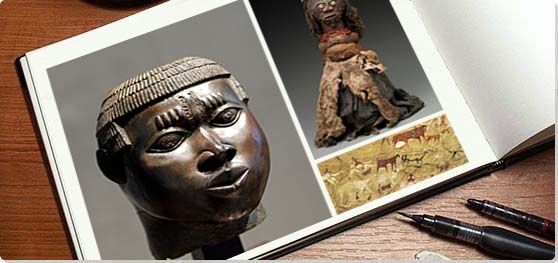Summary of Traditional African Art
The histories and lineages of African art are as diverse as the communities and cultures that traverse the continent. From the ornate cave paintings of South Africa's Cederberg Mountains to the abstract masks of myriad regional traditions, African art incorporates an extraordinary array of objects, materials, media, and themes. One striking aspect of African painting, pottery, and sculpture to Western viewers might be its marked difference from historical works produced in the European Renaissance tradition, with their emphasis on vanishing-point perspective and a form of naturalistic representation. Equally, traditional African art should be explored on its own termsand for the themes and motifs that unite much of it: for example, the production of objects and costumes for religious and ritual purposes.
Key Ideas & Accomplishments
- Amongst the best-known examples of traditional African art are the striking masks produced by many cultures across the continent: from the Zamble masks of the Guro culture (located in present-day Ivory Coast), to Yoruba, Lulua, and Goma facial adornments - created by communities in Nigeria, Congo, and Tanzania. These masks often had a precise religious or ritual function, seen to take on magical properties in the context of a particular rite or event. They also had an incalculable impact on the development of modern art in Europe during the early 20th century, with Cubists such as Pablo Picasso deeply moved and influenced by their animated abstraction.
- Traditional African art shares marked characteristics, in spite of its geographical differences. For example, many African sculptures are united by their intended function as talismans or vessels for communicating with the dead ancestors during religious events. As such, many works remind us of the close relationship between art and spirituality throughout human history; the fact that centuries-old traditions have survived in many African cultures gives us a vital window on the origins of human creativity.
- Pottery is a key form for many African artistic cultures. Jugs and vessels were often created with a utilitarian or domestic function in mind, yet also with great attention to visual beauty and detail. The case of African pottery indicates the less rigorous boundary placed between fine art and practical craftsmanship than in the Western tradition. In fact, this approach mirrored twentieth-century Western movements such as Constructivism, again indicating the ways in which traditional African art predicts and preempts Western equivalents.
- African art cannot be considered today apart from the controversies concerning its location in museums and galleries across the West. Works such as the Benin Bronzes - which the Nigerian government has repeatedly petitioned to have returned - were plundered by colonial empires and often sold on, hence their dispersal across Europe and North America. They therefore stand as markers of a global debate concerning the need for compensation and reparation following the violent subjugation of African societies by European states.
Overview of Traditional African Art
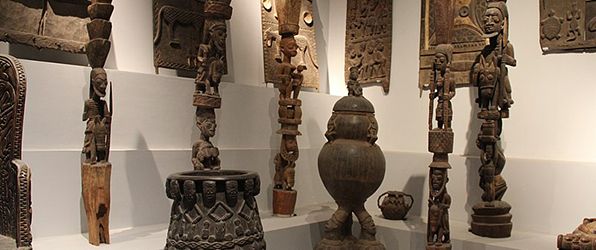
The traditions of African art are rich in their variety of objects, materials, and media, including sculpture, pottery, metalwork, painting, and textiles. While artworks differ depending on geographical area, historically African art has shared some underlying characteristics - including the fact that, unlike in the Western world, objects are often created for religious, ritual, or practical functions.
Artworks and Artists of Traditional African Art
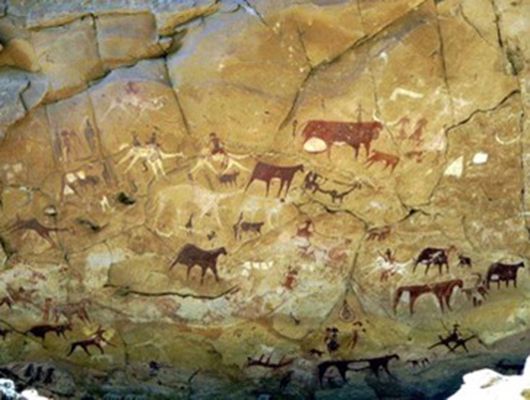
Untitled rock painting
Chad's Manda Guéli Cave is home to an array of painted figures and animals, including cattle and camels. This diversity of forms highlights an interesting feature of African rock art. Unlike in Europe, where cave paintings were not created beyond prehistoric times, many African cultures continued to produce this style of painting well after humans had settled in agricultural communities. Because of this, works like the above can be divided into four distinct categories, identifiable by the types of animals depicted. Early paintings tend to include wild animals such as bison and elephants, with later phases incorporating first cattle, then horses, and finally camels.
The depiction of camels in this work places it in the last category of cave paintings, helping archaeologists to date the work. The presence of human figures interacting with animals, meanwhile, confirms this piece as a product of a period of domestication, well after the earliest, hunter-gatherer phase of human development had ended. Again, this suggests that this is a later cave painting.
At the same time, the work also seems to serve as an abstract visual diary, or a series of time-stamps stretching across centuries. The fact that camels are depicted alongside, and sometimes seem to be transposed on top of cattle, supports the ideas that in many African caves paintings were not created during single phases of history. Rather, later groups of artists would have added to existing paintings with their own images, creating a remarkable graphic record of the passage of time and human development: indeed, works of African cave art provide a unique and captivating insight into past cultures in a way few other works of human creativity can match.
Pigment on Rock - Manda Guéli Cave, Ennedi Mountains, Chad, Central Africa
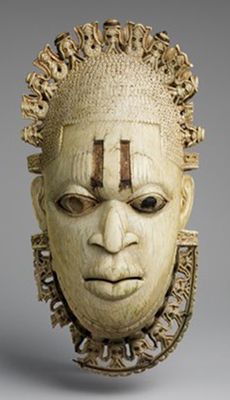
Queen Mother Pendant Mask: Iyoba
This artwork is one of a pair of African ivory masks featuring the face of a woman from the African country of Benin. Exquisitely detailed, these are arguably the most important historical works of the Edo people. As the Metropolitan Museum of Art notes, "although images of women are rare in Benin's courtly tradition, these two works have come to symbolize the legacy of a dynasty that continues to the present day. The pendant mask is believed to have been produced for...the king of Benin, to honor his mother, Idia. The oba [or king] may have worn it at rites commemorating his mother, although today such pendants are worn at annual ceremonies of spiritual renewal and purification."
The details of this sculptural work are highly significant to its symbolic and communal meaning. First, the impression of scarification or tattooing on the face reflects a rite common amongst the Benin people - although the distinct facial features would have been based on the appearance of the individual, regal subject. However it is the headdress and collar that are perhaps the most interesting, as they tell a story of foreign influence. The Metropolitan Museum notes the presence of "carved stylized mudfish and the bearded faces of Portuguese [sailors]. Because they live on land and in the water mudfish represent the king's dual nature as human and divine. Having come from across the seas, the Portuguese were considered denizens of the spirit realm who brought wealth and power to the oba."
Features like those described show the power of much historical African art to make visual statements about influences on a particular culture or community. This can be compared to the densely allusive references that populate religious paintings of the European Renaissance, for example. At the same time, the ceremonial function of artworks like the above mark them out from the purely ornamental and symbolic value of most Western works from the same era. For this reason, traditional African art provides an alternative rubric for thinking about the very essence and purpose of art, and is of the utmost importance to all who want a better understanding of the subject at a global level.
Ivory, iron, copper - Collection of The Metropolitan Museum of Art, New York, New York
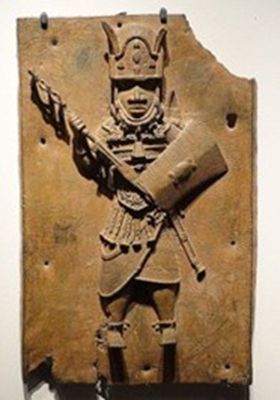
Military Leader
This small relief plaque, measuring little more than a foot high and a foot wide, features a warrior dressed in full armor with spear in one hand and shield in the other. His direct and intense frontal gaze is barely visible under his large helmet, fastened with a chin strap. The background is notably replete with detail, including finely inscribed lines in the shape of large three-petaled flowers, or perhaps leaves.
This work is one of thousands of plaques known as the Benin Bronzes, carved in brass by artists from the Benin Kingdom - part of modern-day Nigeria - several centuries ago. These pieces show the role that art can play in communicating a political statement or as a vehicle for propaganda. The Benin people were known for their military might and relief sculptures like this were used to reinforce the impression of this power to friend and foe by depicting warriors and leading military figures alongside the king, his family, and his attendants.
While they should be treasured for their aesthetic and historical value, the Benin Bronzes also speak to a very modern predicament. According to the Ethnologisches Museum itself, these "historical 'bronzes' and ivory objects from Benin are seen as symbols of colonial collecting and their presence outside Nigeria is widely understood as a sign of colonial injustice." During the 19th century, British troops attacked Benin, bringing the kingdom under colonial rule and looting much of its artwork, including these plaques. The Benin Bronzes were amongst the array of artefacts brought back to England, from where many were sold, ending up in private collections and museums around the world. The present-day Nigerian government, alongside innumerable activists, artists, and citizens, are pressing for these treasures to be returned to their native region.
Brass - Collection of Ethnologisches Museum, Berlin, Germany
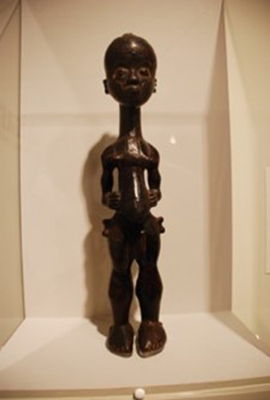
Female Figure
This wooden sculpture depicts a female with an elongated neck, a frontal gaze, and arms bent at 90 degree angles resting formally at her side. A good deal of fine detail is evident in this work, including around her sandaled feet and the marks on her chest and shoulders.This statue was produced by an artist who belonged to the Bena Lulua people in present-day Democratic Republic of the Congo. The figurative sculptural tradition of this region is diverse in that it features both women and men and distinguishes between citizens, rulers, and warriors. However, all Lulua sculptures tend to bear several important features in common, allowing them to be identified clearly as products of their time, place, and culture.
As African art expert Frank Willett notes, "the figurines of the Bena Lulua are highly distinctive. They show elaborate scarifications and usually have the navel emphasized presumably because it represents the physical link to the ancestors." Such geographical distinctions between artworks, especially with regards to the representation of the human body, indicate the breadth and complexity of historical traditions within African art. This disproves the outmoded idea that African artistic traditions are in any sense uniform or unsophisticated.
It is also worth noting the similarities between the formal distortions of the Bena Lulua figurines and the work of modern European artists known for elongated depictions of the human form, such as Alberto Giacometti and Amedeo Modigliani. This is one of analogies that can be drawn between traditional African art and modern Western art, and another indication of the great significance of historical African art.
Wood with traces of tukula pigment - Collection of Honolulu Museum of Art, Honolulu, Hawaii
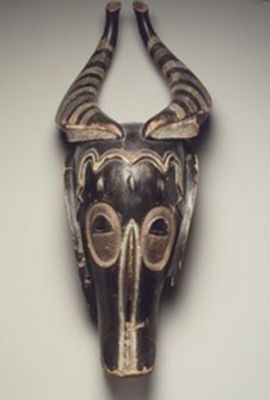
Zamble Helmet Crest Mask
This mask is typical of the style of the Guro culture of the Ivory Coast. With its elongated nose and large eyes, its other key distinguishing feature are the striped horns protruding from its forehead. The Guro people shape this type of mask to resemble a mythical creature called the Zamble which, according to African art expert Frank Willett, is "a mysterious being which resembles a beautiful, strong, young man. These qualities are reflected by its form - the beauty of the antelope and the strong teeth of the leopard together with the youthful rapidity of its dance steps."
With its strong association with death, this mask indicates the importance of the spiritual world to the Guro people. According to the Art Institute of Chicago, Zamble masks would be worn "on the occasion of a man's second funeral, which would be organized months or years after the actual burial to commemorate the accomplishments of the deceased. Performances took the form of competitions between mask dancers from two different families."
Works such as this mask show the vital role that much African art plays in ceremonies and religious events. The significance of masks generally extends far beyond that of a prop or performance aid. Instead, they are vital component of the ritual and often endowed with magical powers. In more recent years, masks such as these have been influential on pop culture in the West, and particularly African-American pop culture, influencing the aesthetics of the Marvel film The Black Panther, for example.
Wood and pigment - Collection of Brooklyn Museum, Brooklyn, New York
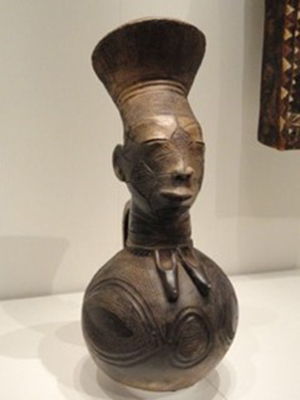
Vessel
A functional piece of pottery, this work shows how African art often combined practical use with artistic design. Most likely used to hold wine, the vessel has also been fashioned to depict the body shape and head of a female, complete with ornate necklace and distinct hairstyle. The elongated facial features are particularly distinctive, indicating the cultural and geographical specificity of the object.
This work is from the Mangbetu culture located in the present-day Democratic Republic of the Congo and provides a good example of the way figures are depicted in the tradition of that community. As historian of African art Frank Willett explains, "the deformation of the head reflects the...practice of binding their babies' heads to make them long and beautiful." Amongst the Mangbetu, art is created by both genders. However, according to the Cleveland Museum of Art, "women were and still are responsible for the making of terracotta pots....It seems, however, that men added the figurative elements".
This pot is believed to have had a utilitarian function. As author Victoria Rovine explains, it would have been "displayed by Mangbetu leaders as they sat in state or used along with a straw to consume palm wine. Pots of this type were also used to hold a mixture of palm wine and a root called naando, consumed by dancers at ceremonial events to energize them and improve their performance." In the early-to-mid 20th century, modern Western art movements such as Constructivism and Concrete Art collapsed the distinction between artistic and functional objects in the same way as some African craftspeople had been doing for centuries. This is another indication of the ways in which traditional African art predicts the evolution of Western art during the 20th century.
Terracotta - Collection of Cleveland Museum of Art, Cleveland Ohio
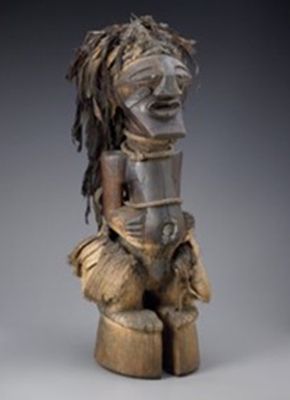
African Songye Power Figure
Carved from wood, this figurative sculpture with distinct facial features is embellished with decorative elements including feathers, fur, and even reptile skin. The piece is typical of a type of large-scale sculptural objects known as a "power figure." Works like these had an important ritual function amongst the Songye communitues in what is now the Democratic Republic of the Congo. Power figures are also an interesting example of the spiritual and religious significance of much African sculpture.
Intended to act as an intermediary between the spirits of dead ancestors and living members of the community, works like these would be commissioned for particular ritual events. Once carved, this item would have been covered with a sacred substance. According to the Indianapolis Museum of Art, such sculptures "derive their authority from the insertion and application of spiritually charged substances. The identity of these substances is secret to the ritual specialist who applies them and varies significantly. Some of the many documented substances include certain river clay, some herbs, ashes of burnt trees from a battleground and the flesh of someone who has [died by] suicide."
Once used in the ritual, the sculptures would remain part of the community, belonging to no individual person. They would also be used in future rituals whenever the need arose to address, according to the Indianapolis Museum of Art, "communal concerns such as crop failure, widespread illness, or a territorial dispute with a neighboring village. The figure with its spiritual charge was considered a protective entity." As such, power figures provide a good example of art being used to help explain and abate the impact of environmental and social disasters through religious narrative. Works like these provide a vital window on the role of creativity in past centuries and millennia, therefore, and can be used to unravel riddles about the origins of art in many other parts of the world, which would likely also have been in protective magic of various kinds.
Wood, cloth, feathers, fur, reptile skin, metals, pigment - Collection of Indianapolis Museum of Art, Indianapolis, Indiana
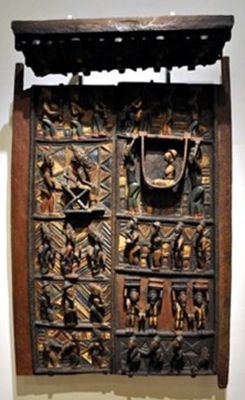
Pair of door panels and a lintel
This elaborately detailed and painted pair of door panels is a masterpiece of relief-carved design. Depicting a narrative across five distinct bands, the panels contain both human figures and, in the background, ornate geometric patterns. This is the work of well-respected artist Olowe of Ise who received many important commissions during his lifetime, including from royalty. According to African art specialist Frank Willett Olowe is "probably the greatest Yoruba virtuoso sculptor. His figures lean out from the door, the upper part being carved fully in the round."
The panel was commissioned to commemorate a historical event for the Yoruba - the arrival of the first British official to the area, Captain Ambrose. The importance of his arrival is indicated by the fact that he is being carried in a hammock to King Ogoga by a number of his attendants in the second-from-top right-hand panel. Directly across from him to the left, the king awaits the introduction seated on his throne, his wife stood behind him. The king is elaborately dressed and wears an ornate crown befitting royalty.
Interestingly there is also a visual message depicted on the lintel above the panels. According to the British Museum this "shows human faces whose eyes are being pecked out by vultures, a common motif in Nigerian royal art, ... probably suggesting the fate of enemies." This work, therefore, has a second layer of meaning, indicating a political agenda whereby the artist is attempting to stir up community pride and pugnacity. It is interesting to compare works like these to the elaborate relief carving of religious alters in the European Renaissance - one of many examples of analogies between historic traditions between continents.
Wood - Collection of British Museum, London, England
Tutu
Nigerian artist Ben Enwonwu's stunning portrait shows a woman looking off to the left, staring absently past the viewer. The colors of the background, her head scarf, and even her skin tone are similarly muted, traversing shades of brown, cream, grey, and white. These appear in contrast to the more vibrant - though still soft - blue of the cloth draped over her left shoulder.
The subject of this painting is one of the Nigerian royal princesses, Adetutu Ademiluyi. Enwonwu's rendering of her, one of three likenesses he created of the princess, became highly revered and helped to cement the artist's reputation. According to author Sarah Cascone, "Enwonwu tracked down the princess in the town of Ile-Ife and convinced the royal family to let him paint her portrait...The painting became a Nigerian icon, a sort of African Mona Lisa; poster reproductions hang on walls all over the country". Interestingly, this painting was lost for several decades before being found in a home in London in 2017, a story which only adds to the magic and mystique of the piece.
This painting is an important example of how traditional themes and approaches informed the development of modern African art. Putting aside the historical example of cave painting, two-dimensional art was in relatively scant evidence across the continent until around the 19th century, to which a wide variety of styles can be dated. Enwonwu, born in Nigeria in 1917, worked in the wake of these traditions and became the most celebrated African painter of the twentieth century. His approach was strongly informed by Yoruba and other regional artistic themes and styles, and is therefore interesting to consider relation to the other works of African art.
Oil on canvas - Private Collection
Untitled
A vibrant and colorful work, this painting by contemporary Ivorian-American artist Aboudia, depicts several abstracted and loosely rendered figures with enlarged eyes staring hauntingly out at the viewer. With its sketch-like quality the work resembles graffiti art - the first medium in which Aboudia worked. It also provides an important example of how today's African artists draw inspiration from and contemporize the essence of early African art. In this case, the influence is particularly evident in the abstracted facial and bodily appearance of his figures.
Abdoulaye Diarrassouba, generally known as Aboudia, was born in the West-African country of Ivory Coast, where violence was a significant part of his upbringing. The country's two civil wars during the 2000s and 2010s became a subject for much of his work, as he turned to art to address the impact of the conflicts on his fellow citizens' psychology. As described by Bonhams, "during the 2011 crisis, Aboudia took refuge in his basement studio where he documented the surrounding violence on large scale canvases that channeled the brutal energy and horrors that were happening above ground. Soldiers with haunted, skull-like faces people these works. The artist has been compared to both Goya and Basquiat for his ability to fuse despair and anger with vigorous energy. Aboudia himself has commented that he uses 'colour to transform sadness into happiness'."
For Aboudia, works like these simply reflect his keen desire to record the physical and emotional parameters of the world around him. At the same time, he has also spoken of himself as a mouthpiece for Ivorian culture. He states: "I was simply describing a situation, to create a record of my country's recent history. Artists, writers, filmmakers are spokespersons for an entire nation, their nation, and the world."
Acrylic and oil-stick on canvas - Private Collection
Beginnings and Development
First Africans to Make Art
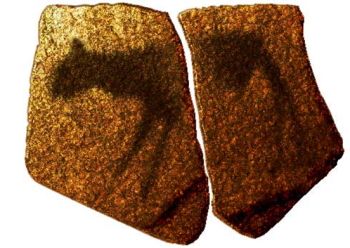
African is home to some of the earliest evidence of art-making anywhere in the world. The first examples of African art include paintings made on rocks and on the interior walls and ceilings of caves. The earliest specimens are works from 23,000 BCE found in the Apollo 11 Cave in Namibia, including depictions of animals and human figures. While the purpose of these drawings will never be known, the fact that they were made at all indicates their significance to the cultures that produced them, given that early humans were hunter-gatherers who did not stay in one place for long.
What was depicted in these earliest paintings helps to shed light on life in this period, providing a record of the animals that lived and served as a food-source at the time. What is more mysterious about these paintings is the inclusion of many composite creatures with both human and animal features. Their depiction has led many to believe that there was a shamanistic and spiritual aspect to the drawings, and that they may have been used in rituals and ceremonies. At the very least, it shows that prehistoric humans in Africa, as elsewhere, possessed highly developed minds capable of rendering imaginary as well as figurative scenes and forms.
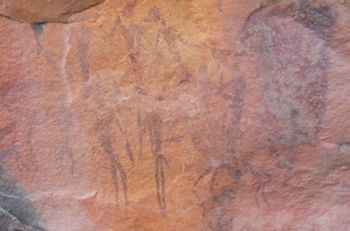
The content of the drawings and the location of these paintings throughout the continent also provide clues as to what life was like for the earliest Africans, including how it changed over decades and centuries. Taking the example of South Africa, African art specialist Frank Willett notes that "the earliest art consists of simple engravings, often scarcely visible....characterized by their peacefulness; the art is moreorless [sic.] naturalistic and there is no recognizably modern subject-matter. The later paintings are less carefully executed and include elaborate scenes of ceremonies, raids and battles. In the early phase of this period the different populations seem to be co-existing peacefully, but the late phase, the paintings of which are mostly concentrated round the south-eastern part of South Africa, reflects a period of constant struggle."
Unlike with European cave art, African art rendered in this style continued to be created long after the Paleolithic period, helping us to reconstruct the story of different communities over a longer timeframe, as well as the history of foreign exploration on the continent. As Willett explains, "it is usually possible to distinguish Bushmen (short stature, painted in yellow, red or brown and carrying bows and arrows), Bantu (tall stature, usually painted in black with ornaments on the arms and legs and armed with spears and shields) and Europeans (recognizable by their characteristic clothing, and often shown with guns and horses). Many allegedly foreign influences have been claimed in the art."
It is important to note that cave paintings were not the only type of art made during early African art history. Some of the oldest examples of African sculpture were produced by cultures associated with modern Nigeria, including Nok figural and animal statues dating back to 500 BCE. The pottery of the Yelwa people, meanwhile, can be traced back to 100 CE and Bura sculptures to 200 CE onwards.
Western Misunderstandings About African Art
For a long time, African art remained unknown to outsiders. It was only during the 15th century that the continent began to be explored - and exploited - by foreign cultures, and African art began to be seen for the first time by Europeans. The artistic cultures discovered often seemed mysterious as they were so unlike anything that had been seen before. This led to misunderstandings and incorrect assumptions about what the art signified, as well as the myth that very little if any art had been made in the centuries prior to European journeys to Africa. According to Frank Willett, "very little art was brought back from Africa until the end of the nineteenth century", and many of the writings produced in that era reflected Eurocentric biases: "they are in some respects fallible guides, for they start from the premise of Western ideas of beauty and all too often express themselves ethnocentrically." It took several decades for a real appreciation and understanding of early African art to begin to be fostered by foreign scholars.
Concepts and Styles
Geographical Distinctions
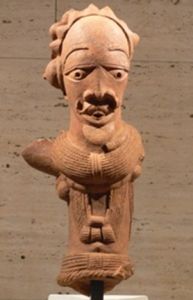
The continent of Africa is vast, and at present comprised of 54 countries. It is no surprise, then, that its historical sculptural traditions are diverse, with significant geographical variations. Speaking of these distinctions, Frank Willett states that: "examples of African sculpture exhibited in museums or illustrated in books on African art are commonly considered to be representative of the style of the people from whom they were collected. William Fagg, for example, writes that 'every tribe is from the point of view of art, a universe to itself. [The tribe] uses art among many other means to express its internal solidarity and self-sufficiency, and conversely its difference from all others.'"
In spite of this diversity, some characteristics are shared in common across the continent. This was especially true during the early centuries of Africa's artistic history. Much of the sculptures and masks produced, for example, were used for religious purposes, whether as ceremonial talismans or, as in the case of Mali's Dogon community, as homes for the spirits of dead ancestors. Many such works are believed to have been originally painted and are small in size to make them portable. As Willett explains, one other feature of historical African sculpture, "which has intrigued scholars from the first is that the head is commonly represented as disproportionately large."
Spiritual Importance of African Sculptures and Masks
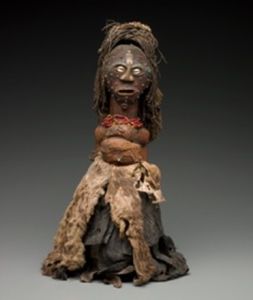
African sculptures produced for religious purposes, as elsewhere, can be imagined as having had a magical power to their creators, helping to bring about the wishes of an individual or community. The three-dimensional art of the Loango people in the Congo, for instance, according to Frank Willett, often includes "nails or metal blades", driven in to them "to activate their power to obtain supernatural aid." The Congo's Songye people, meanwhile, believe their figural sculptures can act as intermediaries between themselves and their dead ancestors.
The spiritual qualities of African art perhaps come across most clearly in the rich variety of masks created throughout the centuries. These are often used in ceremonies and ritual performances, and many tribes believe that when masks are worn in this context the wearer is able to communicate with the dead, with gods, or with other supernatural forces. While the style and distinguishing features of these masks often vary with geographical location, an interesting commonality is that most African masks were not intended to be shown or shared outside the community. Sometimes, masks were not even made visible to the community itself except in specific contexts such as ceremonies and celebrations.
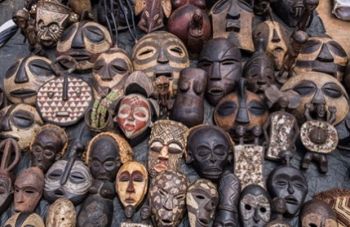
As Frank Willett explains, even today "most people interested in African sculpture are unable to see it in use, and must form their own impressions from museum displays. A museum usually possesses only the wooden part of a mask, which it may display under a spotlight which projects a single interpretation of the sculpture. Kenneth Murray has pointed out that masks 'are intended to be seen in movement in a dance; frequently one which is inferior when held in the hand looks more effective than a finer carving when seen with its costume. It is moreover, essential to see masks in use before judging what they express, for it is easy to read into an isolated masks what was never meant to be there.'"
As foreign travel to Africa became more common, these masks were increasingly brought back home to explorers' own countries, and fascination with this striking artistic tradition grew. Over time, the original sanctity of these items has been increasingly forgotten, with copies of masks sold commercially and even displayed as decorative items in homes.
Early Developments in Pottery
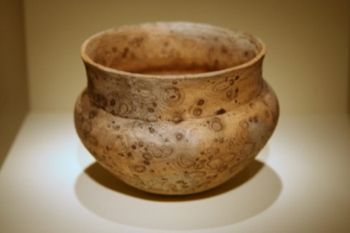
While the Ancient Greeks are often credited for their developments in pottery, there is a rich tradition of same practice in Africa. In fact, as Frank Willett explains, "pottery appears to have been made in Africa for longer than anywhere else in the world. It has been dated to the tenth and eighth millennia BC in the central Sahara."
Despite the rich variety of African pottery, as with much of the art of this continent, it took a long time for work to be discovered and valued across the rest of the world. According to writer and curator Diana Lyn Roberts, "until recently, African ceramics has held a somewhat peripheral position in the Western artistic consciousness and in museum holdings. The influence of African art on the early Modernists is a common axiom in the Western canon...but the weight of art history - and the colonial collections that inform it - rests almost entirely on the shoulders of carved masks and figurative sculpture....Yet the prominence of ceramics in traditional daily life and ritual, not to mention indigenous systems of value and connoisseurship, tells a different story of the African engagement with clay and aesthetic continuities between materials."
The types and techniques of African pottery are as diverse as the different geographical locations where it is created and the groups of people who make it. Early on, works were often made without the use of a wheel, instead formed using the older "coil" method. This labor-intensive process, which was mostly undertaken by women, even involved crushing the clay by hand before it was worked to make the pottery. While many works of African pottery are purely functional and often used to carry liquids, others are highly decorative and have a decorative, even figurative, element - these works have generally appealed most to outsiders. This carries true to this day, with pottery still heavily produced in Africa.
African Textiles
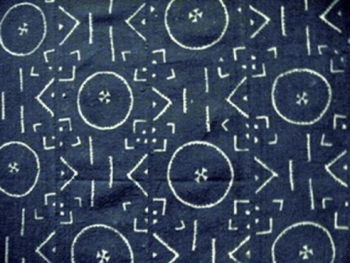
While sculptures and masks are arguably the most widely recognized types of African art, textile design and manufacturing have also been an important aspect of art-making throughout the continent's history. The fabrics produced, as well as the processes used, tend to vary by country, as do norms concerning the gender of the weaver.
The patterns, designs, and colors used are of key importance in helping to make many examples of African textile works of art. Indigo is one of the most popular colors, along with shades of red and green. Traditional practices are employed to dye textiles. Resist dyeing, in which wax is applied to certain areas of a cloth and then dye applied to seep into the uncovered areas, is one of the most common techniques. However, other traditions also exist. In Mali, the favored method is mud-dyeing, using the natural mud from ponds to stain fabrics.
As with so much African art, textiles can often have both a functional use, for example, in the home or as clothing, and a spiritual role, used for costumes worn in ceremonies and rituals. While textile-making has been part of life in Africa for centuries, its popularity continues to grow to this day. Today, African textiles have achieved wide global appeal and have influenced both clothing and interior décor across the world. This has led some to consider African textiles to have transitioned in some cases from a type of fine art to a commercial product due to their popularity and use.
Interestingly, African textile production is not without controversy, as some believe the most popular designs are in fact based on designs from the Caribbean which were brought to be traded in West Africa by Dutch merchants. West-African craftspeople began incorporating these styles into their own designs. For some, this prevents many examples of African textiles from being considered uniquely and originally African.
Regardless of the origins, African textile designs continue to evolve today and have influenced many contemporary designers. Outlining the extent of their current appeal, author Franck Kuwonu states that "American artists such as Beyoncé Knowles, Rihanna, Madonna; politicians and world leaders like Nelson Mandela, Ghana's president Nana Addo Dankwa Akuffo Addo,...first ladies Michelle Obama and Jill Biden, have all embraced...Afrochic designs."
Later Developments and Legacy
Contemporary Debates Over Ownership of Traditional African Art
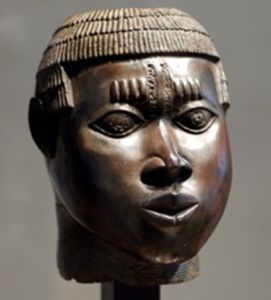
Many Africa countries fell victim to the plundering of the colonial era, with works of art taken without consent and placed in museums and galleries around the world. This has resulted in a decades-long effort on the part of many African nations to have historic works repatriated.
Perhaps the most famous case involves a group of sculptural busts and plaques known as the Benin Bronzes. In 1897, it is estimated that thousands of Nigerian works from the Benin Kingdom were taken from the country by British troops. Today, these pieces are in museums around the world, including 900 included in the collection of the British Museum. While works in private collections would be almost impossible to retrieve, serious efforts have been made to have works returned. According to author Alex Greenberger, "for many Nigerians, the Benin Bronzes are a potent reminder of colonialism and its continued effects on African society....Nigerians have continued to demand that museums across the world give back their Benin Bronzes."
While some institutions and governments have begun to seriously discuss returning the Benin Bronzes they own, progress has been slow. It is this inaction that has frustrated many Africans, including artist Victor Ehikhamenor, who has written that "generations of Africans have already lost incalculable history and cultural reference points because of the absence of some of the best artworks created on the continent. We shouldn't have to ask, over and over, to get back what is ours."
Legacy of African Art
Today, Africa can boast a myriad of intersecting artistic traditions, with many modern and contemporary African artists responding to the historical precedents of their nation or community (this is to say nothing of the huge array of African artists working in a more transnational, contemporary or post-conceptual style). Take, for example, the sculptural figures of Peju Alatise, the figures depicted in the paintings of Aboudia and Ben Enwonwu, and the textile sculptures of Nnenna Okore. Speaking of the importance of working in the traditions of her native country and furthering the reputation of African art, Alatise states: "in my opinion, art from Africa remains still largely burdened by negative social, political and economic realities from its mother continent, hence, is unable to be judged by its own merit and without negative bias or condescending patronage. However, Africans must take the responsibility upon themselves to project their own art and learn to value them as one of their greatest cultural exports."
The legacy of African art in the West, meanwhile, cannot be considered apart from the European modernist movements of the late 19th and early 20th centuries. Artists such as Georges Braque, André Derain, Juan Gris, Amedeo Modigliani, and Pablo Picasso found it to be the source of great inspiration because of its distinctions from post-Renaissance traditions of art. According to one historical account, Henri Matisse and Pablo Picasso were emotionally overwhelmed on encountering their first African mask in the studio of their friend André Derain.
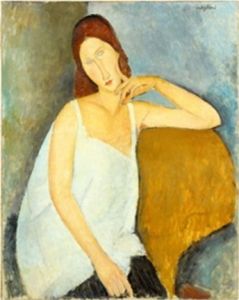
The work of these modern artists often clearly shows the influence of African art in the elongation of faces and eyes, while the long necks of figures in Modigliani's portraits bear a striking resemblance to early African masks. In explaining this influence, author Carolina Sanmiguel states that "modern artists were...attracted to African art because it signified an opportunity to escape the rigid and outdated traditions that governed the artistic practice of 19th-century Western academic painting. Contrasting from the Western tradition, African art was not concerned with the canonical ideals of beauty nor with the idea of rendering nature with fidelity to reality. Instead, they cared about representing what they 'knew' rather than what they 'saw'."
Still, African art was so influential on some early modern artists such as Braque and Picasso that they used its forms and structure as the building blocks for the development of the early modern art movement Cubism. According to Sanmiguel, "the impact of African art's intense expression, structural clarity, and simplified forms inspired these artists to create fragmented geometrical compositions full of overlapping planes." An early example is Picasso's iconic painting, Les Demoiselles d'Avignon (1907). Often considered to be a work documenting the transition of his work into Cubist style, the faces of the women in the brothel have the distinct appearance of African masks.
Cubism was not the only modern movement influenced by African art. Its impact can also be seen in works of Fauvism and German Expressionism. As Sanmiguel asserts, "[it] is also visible in the bold angular brushstrokes of Abstract Expressionists such as Willem de Kooning. And of course, contemporary artists as diverse as Jasper Johns, Roy Lichtenstein, Jean-Michel Basquiat, and David Salle have also incorporated African imagery into their works."
It can be argued that many works of modern art inspired by African art, and even certain movements such as Primitivism, which developed at the end of the 19th century and drew inspiration from African and other tribal arts, helped to perpetuate the myth that African art reflected a state of uncivilized naivety. This was a misconception that would take decades to right, and is still addressed by some contemporary African artists.
Contemporary artists were not, however, the first artists to find fault with the treatment of African sources in modern Western art. Cuban artist Wifredo Lam, for instance, was inspired by African culture but tried to show it differently than many of his European contemporaries. He sought through his work to convey the sophistication and complexity of early African art. According to author Brendan Sainsbury, "for Lam, primitivism meant something more profound. Africa was in his heritage....He even went so far as to align himself with the Afrocubanismo movement which strived...to give greater legitimacy to Black culture by using art to integrate it more deeply into...society."
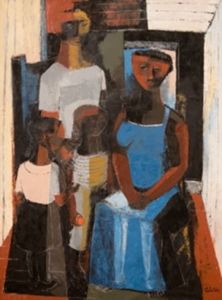
European modernists were not the only artists to find inspiration in African art. African-American artists were also deeply moved by this art, with its rich legacy of masks and sculptures, and drew on it when developing the Harlem Renaissance art movement. Artists including Charles Henry Alston, Romare Bearden, Aaron Douglas, and Jacob Lawrence were all influenced by African art, and wanted to build on its legacy by creating artworks that elevated the Black experience in America. As author Shira Wolfe explains, "Douglas combined imagery from African-American history with scenes from contemporary life ... Douglas was influenced by modernist movements such as Cubism, and he and other artists also found a great source of inspiration in West Africa, in particular the stylised sculptures and masks from Benin, Congo and Senegal. They viewed this art as a link to their African heritage."
